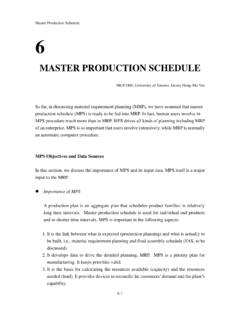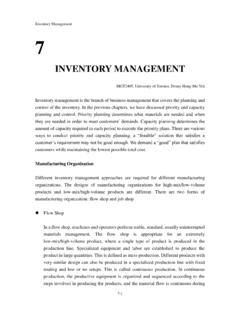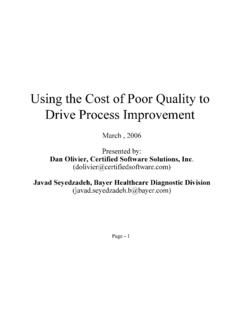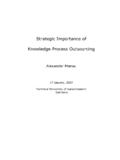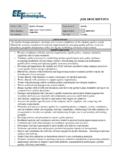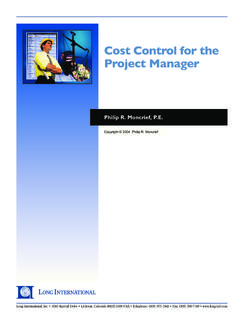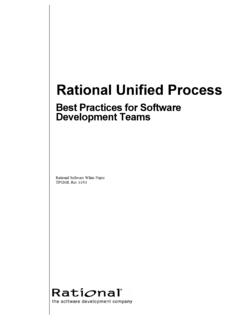Transcription of CHAPTER EIGHT: JUST-IN-TIME CONCEPT - …
1 JUST-IN-TIME Manufacturing 8-1 8 JUST-IN-TIME MANUFACTURING MGT2405, University of Toronto, Denny Hong-Mo Yeh JUST-IN-TIME (JIT) manufacturing has been implemented successfully in Japan for the past 20 years. It is a philosophy as well as a technique that guides a manufacturing company in organizing and managing its business more effectively, and in planning and controlling its operations more efficiently. It is a way to achieve high velocity manufacturing. High Velocity Manufacturing Traditionally, a manufacturing business competes on price, quality, variety, after service, etc. Now, these conditions are merely prerequisites. Few businesses exist today without offering low prices, high quality, and good service. The key competitive factor has become speed. All else being equal, the faster a business responds to its customers, the more profitable it is.
2 The shorter the lead- time in which a manufacturer can supply its products, the higher the probability that it will survive. High velocity manufacturing is a common goal for all manufacturing businesses. In high velocity manufacturing, everything is moving. Machines, people, funds and materials are constantly moving. Therefore, inventories in storage or on the shop floor are moving inventories rather than sitting inventories. Inventories are stocked only for a very short time , and will move to other locations only moments after being stocked. The conditions of high velocity manufacturing include flow manufacturing, line balancing, level schedule, and linearity. Flow Manufacturing A product or a group of similar products are processed through a series of workstations arranged in a fixed sequence. The materials flow through each workstation at a constant production rate.
3 JUST-IN-TIME Manufacturing 8-2 Line balancing Line balancing is required in high velocity manufacturing. Under this condition, tasks must be designed so that the work assigned to each workstation will require about the same amount of time to complete. There is no bottleneck and no buildup of work-in-process (WIP) inventories. For cases where bottlenecks are unavoidable, the theory of constraints (TOC) is applied. TOC will be discussed later. Level Schedule The schedule sets the flow of material coming into and passing through the manufacturing system. Since the flow of materials must be even in a high velocity manufacturing system, the schedules are designed to be level. Linearity Linearity refers to production at a constant rate or the use of resources at a level rate that is measured at least daily. Objective of JIT JIT Manufacturing tries to smooth the flow of materials from the suppliers to the customers, thereby increasing the speed of the manufacturing process.
4 The objectives of JIT is to change the manufacturing system gradually rather than drastically: 1. To be more responsive to customers, 2. To have better communication among departments and suppliers, 3. To be more flexible, 4. To achieve better quality, 5. To reduce product cost . JIT CONCEPT The operations planning and control system is an information system running throughout the manufacturing environment. Although there is a common system framework as JUST-IN-TIME Manufacturing 8-3 discussed in CHAPTER one, systems run in different ways in different environments. For example, dedicated special facilities are used in make-to-stock environments; general purpose machines are used in make-to-order environments. Dedicated production lines can be designed in a balanced way with minimal setups in order to maximize the flow rate of the materials, while a general purpose machine must be set up before producing a specific item.
5 In setup operations, the material flow is interrupted. Manufacturing environments can be changed to make planning and control systems simpler and more effective. For example, products are designed to have high similarity in processing and are mixed in a dedicated production line with negligible setups. Since lead-times are shortened, this turns a make-to-stock product into a make-to-order product. JUST-IN-TIME is not only a control technique, but also a way to improve the manufacturing environment. JIT control systems are only effective in JIT environments. Introducing kanban systems into a non-JIT environment means nothing to a company. JIT Control can be incorporated into an ERP system as a control part with a condition that the system has to be in a JIT environment. The JIT philosophy guides the development of the JIT environment. The JIT environment provides the foundation for implementing the JIT control techniques.
6 The JIT philosophy, JIT environment, and the JIT technique can be expressed in Figure 1. JUST-IN-TIME Manufacturing 8-4 JIT Philosophy JIT Environment PP MPS RCCP MRP CRP JIT Control Figure 1: JIT CONCEPT JIT as a Philosophy Elimination of waste Any activity that does not add value to the product or service in the eyes of the customer is a waste. Poor product design such as the inclusion of fancy functions not required by the customer is a waste. A product design causing difficulty in manufacturing is a waste. Standardization reduces the planning and control efforts, the number of parts, and the inventory required.
7 A poor product design without enough standardization leads to waste. In addition to waste resulting from poor design, Toyota identifies seven examples of waste resulting from poor manufacturing methods. 1. Waste of overproduction Overproduction is the production of goods more than what are immediately JUST-IN-TIME Manufacturing 8-5 needed. Overproduction causes extra material handling, quality problems, and unnecessary inventories. Consuming materials for unnecessary products may cause a shortage of material for other products that are needed. Never overproduce products to keep men and machines busy. If the required loading is less than the capacity, leave it alone. The labor can be switched to other departments, cleaning or maintaining the machines, accepting training and education, etc. 2. Waste of waiting A material waiting in queue is a waste.
8 An operator waiting for material or instruction and having no productive work to do is a waste. 3. Waste of movement Poor plant layout results in materials having to be moved extra distances and cause unnecessary material handling costs. Work centers should be close to each other in order to reduce the move distance. Someone may say that close work centers provide no room for WIP inventories. That is fine! No room for WIP inventory forces the WIP to decrease. 4. Waste of inventories Inventory causes costs of interest, space, record keeping, and obsolescence. Moreover, inventory can mask problems which could cause more inventory buildup. For example, WIP inventory between work centers can hide the symptoms of an unbalanced production rate. Finished goods inventory can mask poor forecasting, poor quality, and poor production control.
9 Inventory is not an asset; it is a waste! 5. Waste of motion Improper methods of performing tasks by the operators cause wasted motions. Reaching far for materials or machine buttons is a waste of motion. Searching for tools is a waste of motion. Any activity that does not add value to the products should be eliminated. Bad layout or training causes waste of motion. JUST-IN-TIME Manufacturing 8-6 6. Waste of making defects The cost of scraps is a waste. But it is the least important compared with other wastes caused by making defects. Defects interrupt the smooth flow of materials in the production line. If the scrap is not identified, next workstation will try using it to produce more wastes, or waste time waiting for good materials. 7. Waste of process itself Bad process design is a waste. For example, wrong type or size of machines, wrong tools, and wrong fixtures are wastes.
10 The principle of eliminating the wastes includes: 1. All waste should be eliminated. 2. Waste can gradually be eliminated by removing small amounts of inventory from the system, correcting the problems that ensue, and then, removing more inventory. 3. The customers' definitions of quality should drive product design and manufacturing system. 4. Manufacturing flexibility is essential to maintain high quality and low cost with an increasingly differentiated product line. 5. Mutual respect and support should exist among an organization, its employees, its suppliers, and its customers. 6. A team effort is required to achieve world class manufacturing capability. 7. The employee who performs a task is the best source of suggested improvements. Continuous improvement/One Less at a time As we have mentioned before, JIT improves the manufacturing system gradually rather than drastically, as in business process reengineering (BPR).


